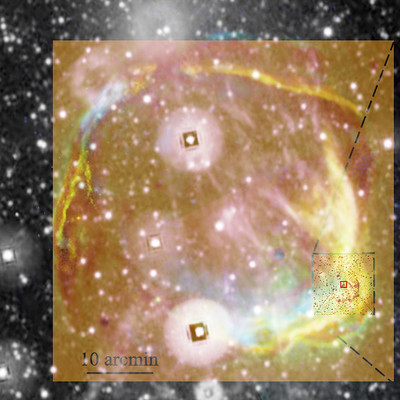Post
by Brad Schaefer » Fri Mar 03, 2023 10:07 am
The supernova remnant RCW 86 did not come from the Chinese Guest Star of 185 AD, and the Guest Star is not from a supernova:
RCW is much older than 1838 years (2023-185). One quick way to see this is to take the caption's quoted size of 100 lightyears (50 ly radius) to calculate the average velocity in 1838 years of 50/1838 = 0.027 times the speed of light, or 8200 km/s. The problem is that 8200 km/s is typical for the velocity at the initial ejection, whereas the ejecta slows down greatly over 1838 years as a stiff power law, so the *average* velocity over 1838 years must be <<8200 km/s. Indeed, the current expansion velocity of RCW 86, as based on the observed proper motion of the remnant (Helder et al. 2013, MNRAS, 435, 910) is 1200 +- 200 km/s. With this, there is no way that the SN of RCW 86 could possibly have been in the year 185 AD.
The Guest Star of 185 AD was not a supernova. The only information about the Guest Star is 50 Chinese characters written c. 300 AD (i.e., 115 years later), with this then further edited in c. 510 AD into a compilation by historians writing the dynastic history of the Later Han Dynasty (the Houhanshu), placing together scattered and brief Imperial records covering several centuries of observations. The *only* evidence that the Guest Star of 185 AD is a supernova is that its duration is long. The star was first reported on 7 December 185, and the disappearance was in the 6th month of the "hounian" year. In ancient Chinese, "hounian" is ambiguous and might mean in 'several years', or it might mean 'next year' with or without inclusive counting. So the disappearance might have been in the sixth month of 186, or 187, or 188 AD. In all these cases, the reported duration of visibility is sufficiently long that a supernova is the only single possibility. (See my similar argument for the case of the Guest Star of 1181 AD being a supernova, in Schaefer 2023, arXiv:2301.04807.) The problem to get the long duration is the requirement that the event in December of 185 must be from the same source as for the reported disappearance in the sixth month of 186/187/188. For this, the Chinese elsewhere recorded the disappearance of a very bright and famous comet in the sixth month of 188 AD in the exact same area of the sky. The comet is P/Swift-Tuttle, the parent comet of the Perseid meteor shower. (Note; APOD will certainly carry pictures of this comet during its close encounter, at 0.153 AU from Earth, on 5 August 2026, reaching near zeroth magnitude.) The coincidence of the known bright comet disappearing at the same time and place as the reported disappearance of the Guest Star is too much, unless there is a causal connection. The causal connection is that the compiler in the year 300 AD took a report of a Guest Star in 185 AD and connected it with the Guest Star in the sixth month of 188 AD that occurred in the same area of the sky. (The December 185 event was most likely an ordinary galactic nova, or even possibly the formation of the giant shell of He 2-111.) Such concatenations of separate events are common in the Chinese dynastic annals, as the compilers only had sketchy reports centuries old that they were trying to form into a coherent account. Such concatenations are reported for for records in 837, 838, and 1592, as well as possibly in 238 BC, AD 277, 902, and 1506. So we have a simple and inevitable case that the Guest Star of 185 is really two separate events (Schaefer 1995, AJ, 110, 1793). This breaks the long duration. And with the long duration gone, we have no evidence that the event was a supernova of any kind.
 RCW 86: Historical Supernova Remnant
RCW 86: Historical Supernova Remnant







